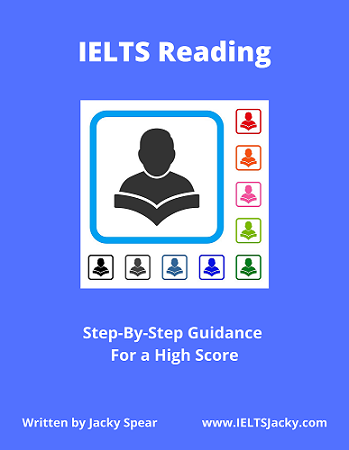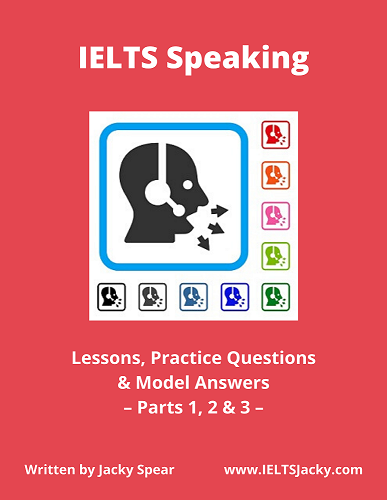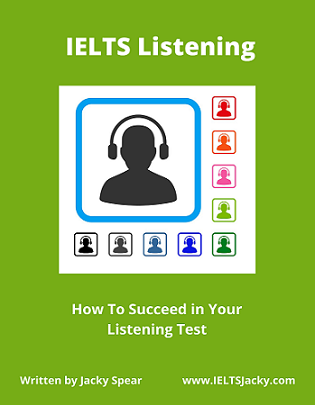Reading Tests For IELTS
How To Answer a Summary Completion Question
Reading tests for IELTS contain many different types of questions. Although you won’t get all of them in your test, it’s important to understand how to answer each type so that you’re well prepared for whichever you happen to get.
On this page, I’m going to show you how to answer a Summary Completion questions. It comes from a real test paper and we’ll work through it step-by-step.
There’s a full page on Summary Completion Questions on the website where you’ll find lots more information and tips. There are also many other sample reading tests for IELTS covering all the other question types. You’ll find a menu at the bottom of this page.
Important Information
& Top Tips
Before we look at the question, here is some important information you need to know, plus a few tips.
What is a summary?
A summary is:
‘a short, clear description that gives the main facts or ideas about something’.
In this case, it’s a short description of information from part of the text that’s been set for your reading test.
What do you have to do?
For summary completion questions, you’ll be given:
1) The text.
2) A summary of information from a section of the text with some gaps where words have been missed out.
You may also be given a list of words to fill the gaps with.
You'll be required to do one of the following tasks:
a) Fill in the gaps with words from the word list
or
b) Fill in the gaps with words from the text.
Key tips
1) Answer order –
The answers are usually in the same order in the text as the order of
the missing words.
2) Words from text questions – Take careful note of how many words you should write for your answer, e.g. NO MORE THAN TWO WORDS. If you write more than this, your answer will be marked wrong even if the information is correct.
3) List of words questions – There will be more words in the list than there are gaps in the summary to fill so you won’t need them all. Your task is to select the correct ones.
There will probably be some words in the list that you can eliminate immediately as clearly being incorrect. This could be because of their meaning or grammar form. Cross them through in pencil so you don’t waste time considering them.
4) Prediction – Try to predict the type of word you’ll need to fill each gap from the context of the sentence. Is it an adjective, a noun, a verb, etc? Doing this will make it much easier to spot the correct word because you’ll have a big clue as to what you’re looking for.
You may also be able to make a pretty good guess at some of the missing words from the context of the sentence.
Reading Tests For IELTS
– Summary
Completion Text & Questions –
Here is the sample test we’re going to be working on. If you want to use it as a practice test, have a go at answering it yourself before reading my instructions.
I’ve added a PDF of the questions and text that you can download to make the task easier. The answers are at the bottom of this page.
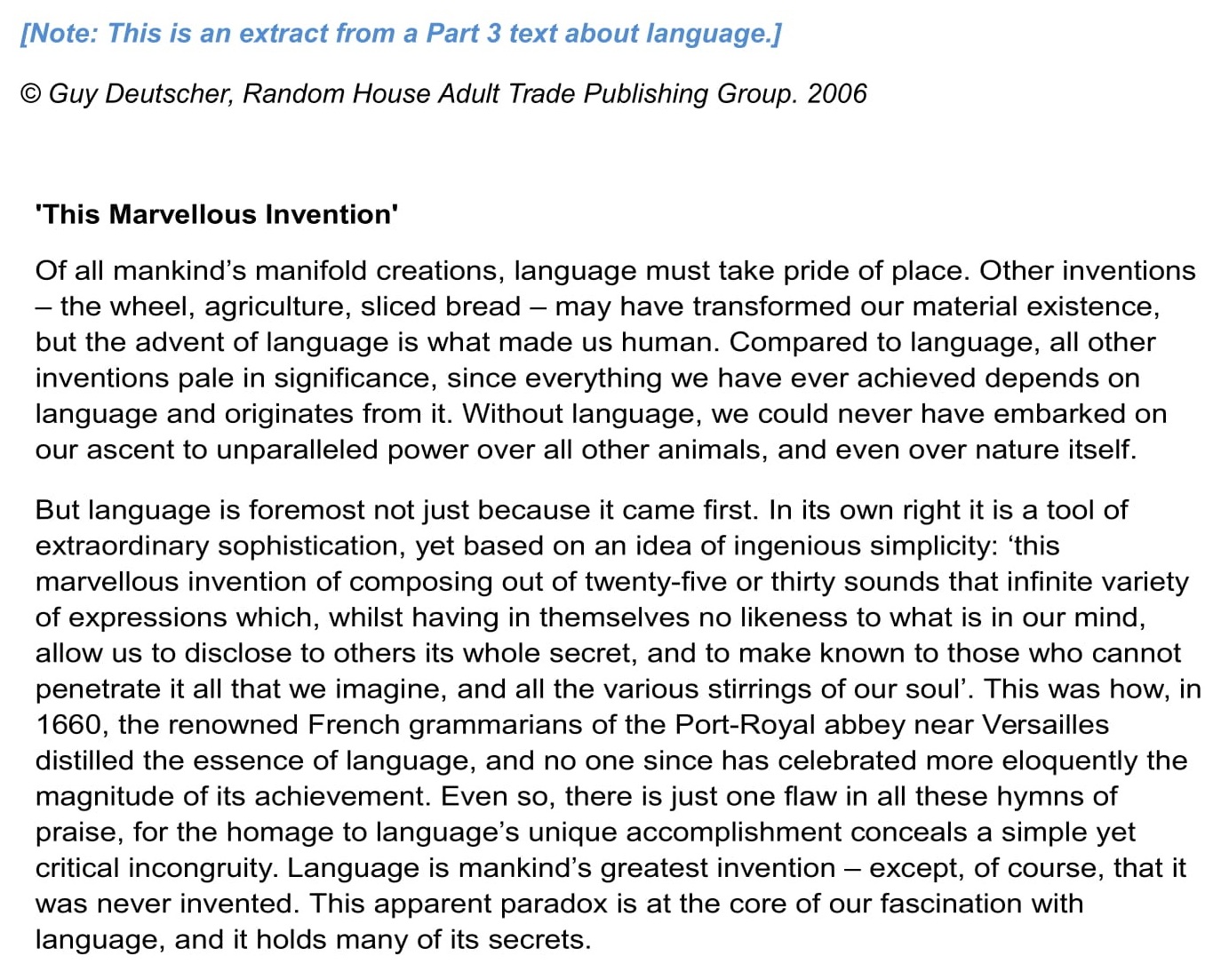
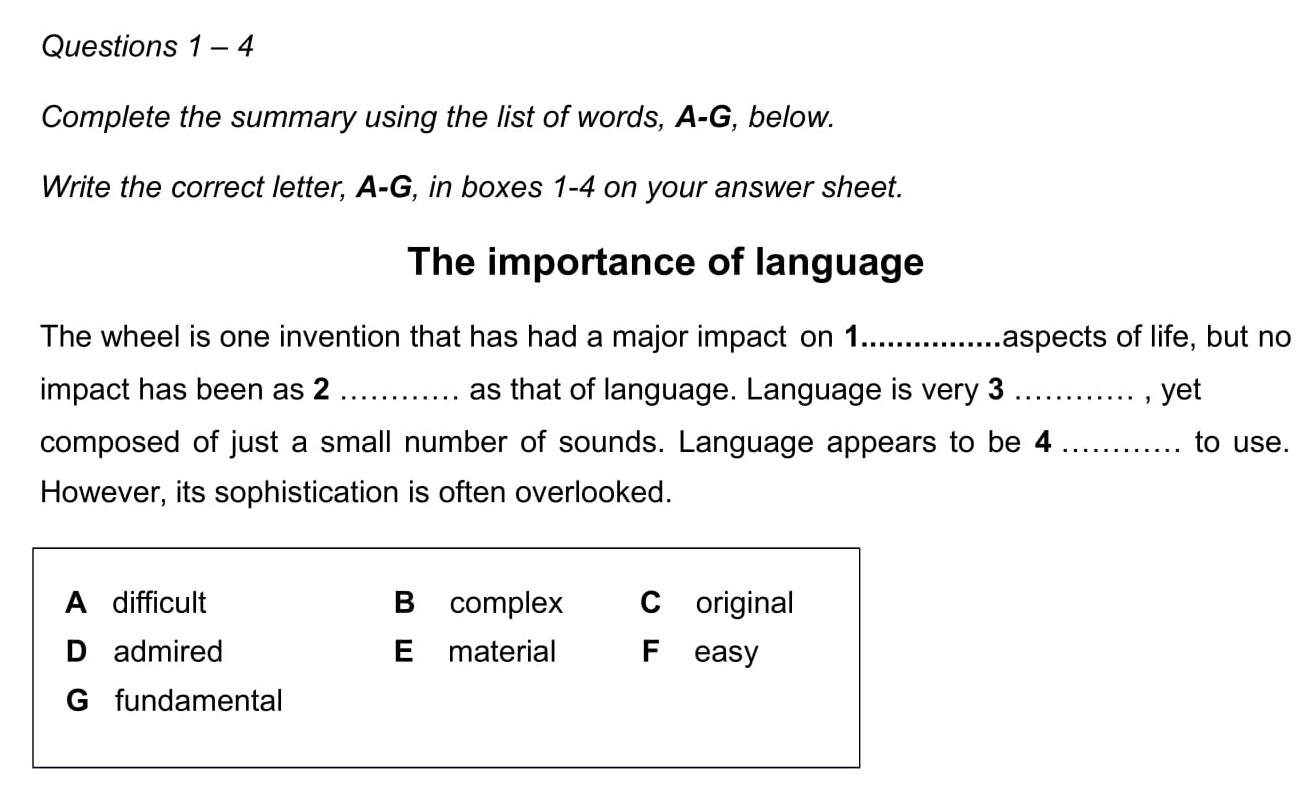
Source of IELTS Reading test practice: Official IELTS Website.
Download PDF of this IELTS Reading paper.
Step-By-Step Instructions
1) Carefully read the instructions, taking particular note of whether the answers will be in the text or a word list. For this question, you have been given a list of words.
2) Read the title and skim read the summary to get a general understanding of what it’s about.
3) Next, read the summary in more detail and try to predict the type of word needed to fill each gap, e.g. verb, noun, adjective.
Also, look at the list of words and see if you can guess any answers. You may be able to narrow some individual answers down to 2 or 3 possibilities. There will be others that are obviously wrong.
Here are a couple of guesses I made on first reading the summary:
2 G - fundamental
3 A - difficult or E - complex
We'll see if I'm right in a minute.
4) The summary will normally relate to one section of the text, probably 2-3 paragraphs. Your next job is to identify this.
Pick out a few key words from the summary to scan for. Names, numbers, places or dates are ideal if there are any in the summary as these will be easy to spot. Remember that synonyms could be used. When you’ve made your selection, scan the text for them.
In this sample test, we have been given the relevant section of text so we don’t need to do this.
5) Next, read the first phrase or sentence of the summary with a gap in it. Try to work out what type of word will fit. In this case, it will be an adjective.
The wheel is one invention that has had a major impact on 1………… aspects of life,
Identify one or two key words and scan the text for them, watching out for synonyms and paraphrasing. As the answers will probably come in order in the text, it should be quite near the beginning.
There’s only one sentence with the word ‘wheel’ in it. It’s the second sentence. This will be the location of the answer. ‘Impact’ is not present so you may need to look for a synonym.
Other inventions – the wheel, agriculture, sliced
bread – may
have transformed our
material existence, but the advent of language is what made us
human.
Before doing so, identify the information related to the ‘wheel’ and check to see if any of the words in the word list, or synonyms of them, are present.
Other inventions – the wheel, agriculture, sliced bread – may have transformed our material existence, but the advent of language is what made us human.
We’re lucky. The word ‘material’ is in both the word list and the text. Check that it makes sense as the missing words and that the sentence is grammatically correct.
It fits perfectly. We’ve found the first answer.
Answer: 1 E (material)
Cross through ‘material’ in the word list to eliminate it from further consideration.
6) Now move on to the next missing word. It’s in the second half of the sentence we’ve just been working with. However, we need to consider it in the context of the whole sentence.
The wheel is one invention that has had a major impact on 1 material aspects of life, but no impact has been as 2 ………… as that of language.
I’ve already predicted that the answer will most likely be ‘fundamental’ so let's check this first.
It certainly makes sense in the sentence and is grammatically correct, but we need to quickly go through the other words in the list to see if any of them would be a better fit.
None make good sense in this gap so we have the right answer.
Answer: 2 G (fundamental)
7) Often, just one small word can give a big clue as to the type of word that's missing, so look out for these.
There’s a good example of this in the sentence containing gap 3. The word is ‘yet’.
Language is very 3 ………… , yet composed of just a small number of sounds.
In this context, it means ‘but’ and tells us that the ideas in the two phrases of the sentence are going to oppose each other in some way.
Start by looking at the information you have:
Language is … composed of just a small number of sounds.
What does this mean? It means that language has a simple composition.
Now look at the list of remaining words and see if any have the opposite meaning to ‘simple’. There are two possibilities:
- A difficult
- B complex
We now need to search the text to find the best match. Scan for the words ‘simple’, difficult’ and ‘complex’ or synonyms of them.
There's one match, 'simplicity'. It's at the beginning of the second paragraph.
But language is foremost not just because it came first. In its own right it is a tool of extraordinary sophistication, yet based on an idea of ingenious simplicity…
The text also contains the conjunction 'yet'. Now read this sentence in detail to see what word has been used here as the opposing idea to 'simplicity' as this will give us the answer.
It's 'sophistication'.
Finally, check the two words we've selected from the word list as possible answers. Which is the closest in meaning to 'sophistication'? It's ‘complex’. This is our answer.
Answer: 3 B (complex)
8) There are now just four words to choose from to fill gap 4.
A difficult B complex C original
D admired E material F easy
G fundamental
Read the sentence and the words. Are there any words that definitely don’t fit the sentence?
Language appears to be 4 ………… to use. However, its sophistication is often overlooked.
Yes, there are.
- C original
- D admired
Neither of these makes sense so we can ignore them.
That leaves us with:
- A difficult
- F easy
These mean the opposite of each other so it should be quite easy to work out which one is correct.
One clue comes in the previous answer as it gave us the meaning of the key word ‘sophistication’ which now appears in the summary. To be 'sophisticated' is to be complex or complicated.
Language appears to be 4 ………… to use. However, its sophistication is often overlooked.
We have a similar situation with this answer as with the last one because the other big clue is in the conjunction (in this case, 'however'), that connects the two sentences and the two halves of the idea.
Like ‘yet’, ‘however’ is also a word that indicates a contrast in ideas. Thus, the missing word is going to mean the opposite of ‘sophistication’ or 'sophisticated'. Therefore, it has to be ‘easy’.
Answer: 4 F (easy)
That completes the question.
You’ll have noticed that we found two of the answers without even looking at the text. Obviously, all reading tests for IELTS are different so this may or not be possible with any question you get in your exam.
However, take every clue from the summary itself that you can. Don’t make answering the question more difficult than it needs to be.
I hope you’ve found these instructions helpful. As already mentioned, I’ve created a full page on Summary Completion questions, including more sample reading tests for IELTS. Click the link to visit the page.
Answers
1 E material
2 G fundamental
3 B complex
4 F easy
Like this page?
More Reading Tests For IELTS
Step-by-step strategies for answering the 12 different types of IELTS Reading questions with examples and practice tests.
You'll Also Find Reading Tests For IELTS Here:
IELTS Reading Sample – True, False, Not Given sample test
IELTS Reading Samples – Matching Headings & Diagram Labelling sample tests
IELTS Reading Practice Test – More examples of Matching Headings and a Diagram Labelling questions & how to answer them
More Reading Test Practice – Matching Information sample test
IELTS Reading Exercise – Yes, No, Not Given sample test
IELTS Reading Tests – Two strategies for answering Name Matching questions
IELTS Reading Paper – Multiple Choice sample test



